Update Notice (13th October 2023) : The data of ‘InnerForce Layer ALC’ has been changed from that of 2018 version to newer 2023 version. ‘InnerForce Layer ALC’s measured in 2023 are thicker, heavier and more elastic than those measured in 2018. TTGearLab will deal with those two versions as different blades.
1. Introduction
Stiga has been famous by many legendary table tennis blades. Most of the legendary blades made by Stiga are all-wood blades. But, Stiga has also tried to make good fiber blades, and the result is very successful ‘Carbonado’ series. ‘Carbonado’ series is successfully competing against fiber blades of Butterfly. Currently 6 models are available in ‘Carbonado’ series – ‘Carbonado 45’, ‘Carbonado 90’, ‘Carbonado 145’, ‘Carbonado 190’, ‘Carbonado 245’ and ‘Carbonado 290’.
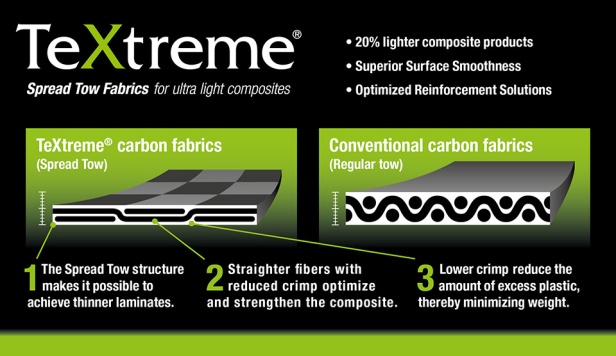
Fig.01 The description on TeXtreme
The fiber for ‘Carbonado’ series is TeXtreme which is very specially produced woven carbon fiber. Differently from conventional carbon fiber, spread tow structure makes the fibers straighter.

Fig.02 The appearance of the surface of TeXtreme
As a result, the surface of TeXtreme is very flat, and it is much thinner than conventional carbon fiber. It requires less epoxy than conventional carbon fiber. By the use of this new material, Stiga succeeded to make ideal carbon blades those are as soft as the blades with mixed fibers such as ALC while providing much better energy efficiency and higher elasticity.
Stiga uses three kinds of TeXtreme. Low density (= 60g/㎡) TeXtreme is used for ‘Carbonado 45’ and ‘Carbonado 90’. Middle density (= 100g/㎡) TeXtreme is used for ‘Carbonado 145’ and ‘Carbonado 190’. And, high density (= 200g/㎡) TeXreme is used for ‘Carbonado 245’ and ‘Carbonado 290’.
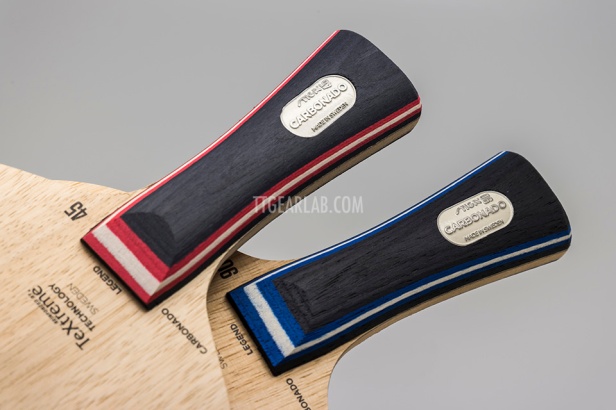
Fig.03 ‘Carbonado 45/90’ – Color of name plates is white

Fig.04 ‘Carbonado 145/190’ – Color of name plates is black
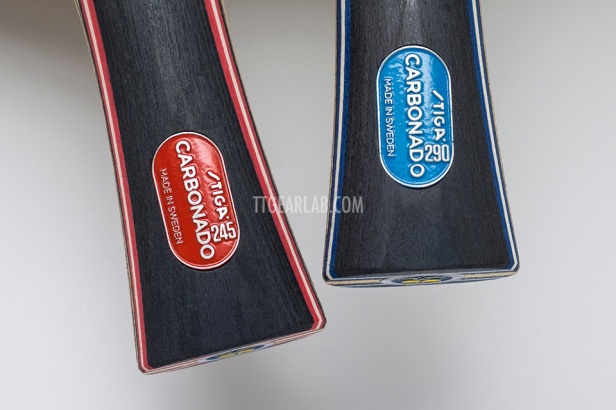
Fig.05 ‘Carbonado 245/290’ – Color of name plates is blue/red
The difference between ‘Carbonado X45’ and ‘Carbonado X90’ is in the orientation of TeXtreme. In ‘Carbonado’ series, ‘X45’ means that the woven fiber is rotated by 45 degree. Therefore the orientations of fibers in ‘X45’ models (= ‘Carbonado 45’, ‘Carbonado 145’ and ‘Carbonado 245’) are not vertical or lateral as in ordinary fiber blades, but ‘+45° from vertical direction and -45° from vertical direction’. it makes the blade softer, less elastic and more resistant to torsion. On the contrary, the fibers in ‘X90’ models (= ‘Carbonado 90’, ‘Carbonado 190’ and ‘Carbonado 290’) are placed in normal direction, like the fibers in most of other fiber blades.
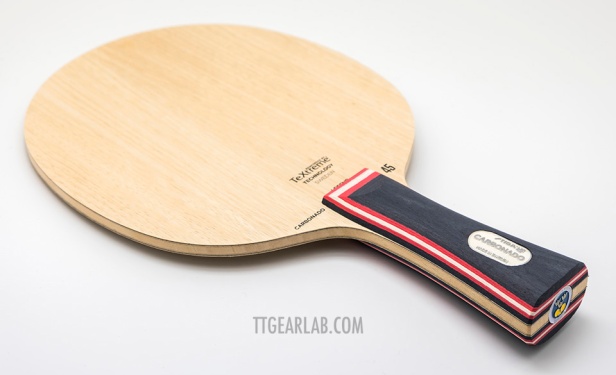
Fig.06 ‘Carbonado 45’
Above picture shows ‘Carbonado 45 which is equipped with low density (= 60g/㎡) TeXtreme placed in the direction rotated by 45 degree. ‘Carbonado 45’ is being used by Li Zhu Yuling and Chen Meng (Chinese Women’s National Team).

Fig.07 ‘Carbonado 90’
Above picture shows ‘Carbonado 90’ which is equipped with low density (= 60g/㎡) TeXtreme placed in ordinary direction (= vertical and lateral).

Fig.08 ‘Carbonado 145’
Above picture shows ‘Carbonado 145 which is equipped with middle density (= 100g/㎡) TeXtreme placed in the direction rotated by 45 degree. ‘Carbonado 145’ is being used by Li Xiaoxia and Sun Yingsha (Chinese Women’s National Team).

Fig.09 ‘Carbonado 190’
Above picture shows ‘Carbonado 190’ which is equipped with middle density (= 100g/㎡) TeXtreme placed in ordinary direction (= vertical and lateral). ‘Carbonado 190’ is being used by Pär Gerell (Swedish Men’s National Team).
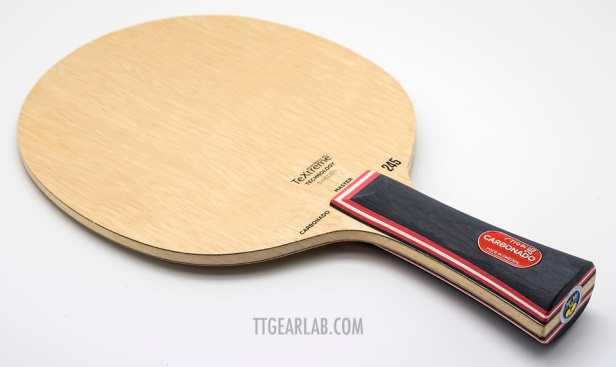
Fig.10 ‘Carbonado 245’
Above picture shows ‘Carbonado 245 which is equipped with high density (= 200g/㎡) TeXtreme placed in the direction rotated by 45 degree. ‘Carbonado 245’ is being used by Kou Lei (Ukraine Men’t National Team).

Fig.11 ‘Carbonado 290’
Above picture shows ‘Carbonado 290’ which is equipped with high density (= 200g/㎡) TeXtreme placed in ordinary direction (= vertical and lateral). ‘Carbonado 290’ is being used by Truls Moregard (Swedish Men’s National Team).
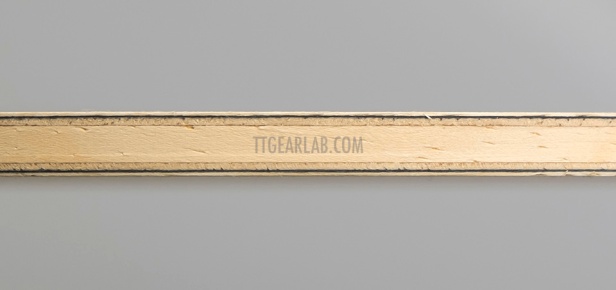
Fig.12 Plywood construction of ‘Carbonado’
TeXtreme is placed directly under top layer. Above picture shows the plywood construction of ‘Carbonado’ series. It is not easy for us to distinguish between one model and another just from the appearance of plywood. The thickness of plywood is about 6.0mm, which is identical for six models.

Fig.13 ‘Carbonado 45/90’
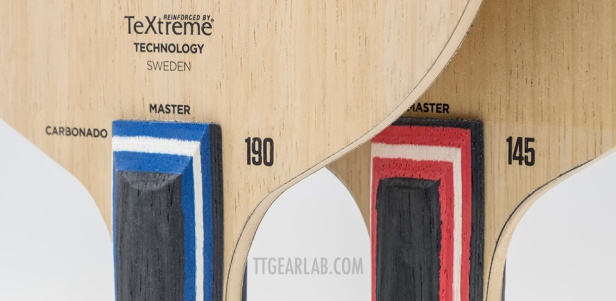
Fig.14 ‘Carbonado 145/190’
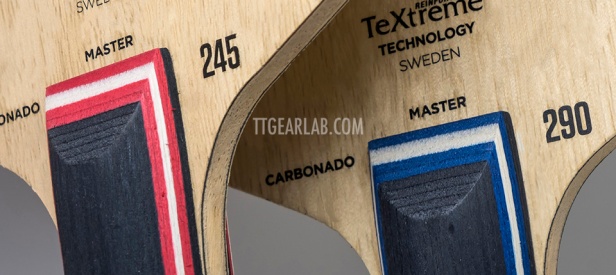
Fig.15 ‘Carbonado 245/290’
By ‘Performance Indices’, we can examine the characteristics of six ‘Carbonado’ models and some Butterfly blades.
2. Blades to be compared
The blades to be compared are as follows :
- Stiga Allround Classic : Reference (all values are 1.0)
- Stiga Carbonado 45 : (Outer) Low density TeXtreme in leaned direction
- Stiga Carbonado 90 : (Outer) Low density TeXtreme in normal direction
- Stiga Carbonado 145 : (Outer) Middle density TeXtreme in leaned direction
- Stiga Carbonado 190 : (Outer) Middle density TeXtreme in normal direction
- Stiga Carbonado 245 : (Outer) High density TeXtreme in leaned direction
- Stiga Carbonado 290 : (Outer) High density TeXtreme in normal direction
- Butterfly Grubba Carbon : Thin carbon blade of ALL+ class
- Butterfly Korbel : Representative of 5-ply wood offensive blade
- Butterfly InnerForce Layer ALC : (Inner) ALC + Limba top layer
- Butterfly Freitas ALC : (Outer) ALC + Limba top layer
- Butterfly Timo Boll ALC : (Outer) ALC + Koto top layer
- Butterfly Zhang Jike Super ZLC : (Outer) ZLC + Koto top layer
‘Allround Classic’ is the representative of traditional all-round blades. And, it is the reference blade of Performance Indices in TTGear Lab. All indices for ‘Allround Classic’ is 1.0.
‘Grubba Carbon’ is the carbon blade for all-round play which is much softer and slower than most of carbon blades.
‘Korbel’ is the representative of 5-ply wood offensive blade. This blade should be compared because ‘Carbonado’ series can be a replacement of 5-ply wood offensive blade for player to get more power in poly ball age.
‘InnerForce Layer ALC’ is a ALC blade with inner-fiber construction. Its top layers is same as ‘Carbonado’ series. It can also be the replacement of 5-ply wood offensive blade for poly ball age.
‘Freitas ALC’, ‘Timo Boll ALC’, ‘Zhange Jike Super ZLC’ are the fiber blades with 5+2 ply ‘outer fiber’ construction. Those are direct competitors of ‘Carbonado’ series.

Fig.16 5+2 ply ‘Outer Fiber construction of ‘Carbonado’ series
Comparison will be done by performance indices. Concerning the detail of four performance indices, please refer to following articles in ‘Background’ section :
- Performance indices : the way to evaluate blade by measurement
- The example of comparison by performance indices
3. Comparison by Performance Indices

Fig.17 Comparison by Elasticity Indices
Fig.17 shows the comparison graph of Elasticity Indices.
Ep (Primary Elasticity Index) is directly concerned with the rebound speed of blade.
As we can expect, the slowest one among ‘Carbonado’ series is ‘Carbonado 45’ (Ep = 1.80) which is equipped with low density TeXtreme rotated by 45 degree, and the fastest one is ‘Carbonado 290’ (Ep = 2.71) which is equipped with high density TeXtreme arranged in ordinary direction. In all cases, a model with higher density TeXtreme is faster than another model with lower density TeXtreme. In case the density of TeXtreme is identical, X90 is faster than X45. By the application of various density and two different arrangements, Stiga is providing wide variation of ‘Carbonado’ series.
Regarding Ec, Ec is lower than Ep for all models of ‘Carbonado’ series. In fact, it can also be easily expected because it is general tendency of fiber blades with ‘outer fiber’ construction. And, in case the density of TeXtreme is identical, the Ec of X45 is lower than that of X90. It means that X45 tends to hold ball more deeply than X90.
When we compare ‘Carbonado’ series with other blades, we can first notice that the elasticity indices of ‘Grubba Carbon’ and ‘Korbel’ are noticeably lower than those of ‘Carbonado’ series. Also, the elasticity indices of ‘InnerForce ALC’ (updated data measured in 2023) is higher than only one model of ‘Carbonado’ series – ‘Carbonado 45’. That is because the plywood construction of ‘Carbonado’ series is ‘outer fiber’ construction that can utilize the elasticity of fiber more effectively. Therefore, if we are just interested in speed of blade, we have to compare ‘Carbonado’ series with ‘outer fiber’ blades such as ‘Freitas ALC’ and ‘Timo Boll ALC’.
The Ep’s of ‘Freitas ALC’ and ‘Timo Boll ALC’ are 2.04 and 2.14 respectively. Those are similar values as that of ‘Carbonado 190’ (Ep = 2.10). But, the Ec of ‘Freitas ALC’ is somewhat higher than that of ‘Carbonado 190’ (1.91 vs. 1.77). On the contrary, the Ep of ‘Timo Boll ALC’ is same as that of ‘Carbonado 190’. Although the top layers of those two are not identical to each other, we can notice similarity between ‘Timo Boll ALC’ and ‘Carbonado 190’. And, we may think that ‘Freitas ALC’ is close to ‘Carbonado 145’ in Ep. However, the Ec of ‘Carbonado 145’ is significantly lower than that of ‘Freitas ALC’ (1.40 vs. 1.91). We can hardly feel that ‘Freitas ALC’ is similar to ‘Carbonado 145’ in the characteristics of elasticity.
‘Zhang Jike Super ZLC'(Ep = 2.55) is noticeably faster than ‘Timo Boll ALC’ (Ep = 2.14). It is also faster than ‘Carbonado 245’ whose Ep is 2.31. But, ‘Carbonado 290’ (Ep = 2.71) is even faster than ‘Zhang Jike Super ZLC’, while its Ec (= 2.18) is similar to that of ‘Zhang Jike Super ZLC’ (Ec = 2.15). From the graph, we can notice that the overall tendency in elasticity of ‘Carbonado 290’ is close to that of ‘Zhang Jike Super ZLC’.
Examining Ec/Ep is an easier way to understand the tendency of elasticity of blades. Fig.18 shows the relationship between Ec/Ep and Ep.
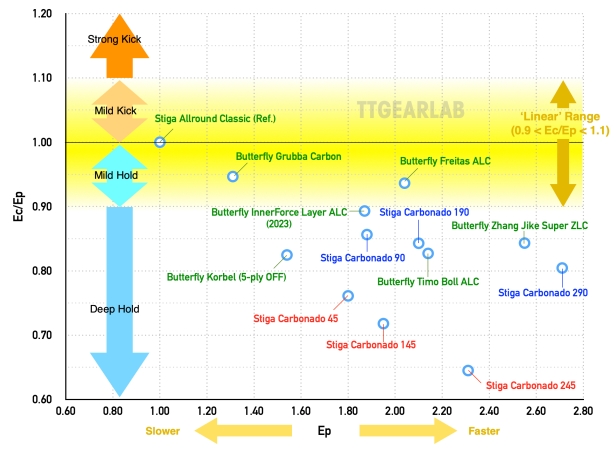
Fig.18 Ec/Ep vs. Ep
Ec/Ep expresses the ‘tendency’ of the elasticity of blade. By examining Ec/Ep and Ep at the same time, we can easily understand the behavior of blades.
On the graph, we can see that three models of ‘Carbonado X45’ are placed lower than three models of ‘Carbonado X90’. I.e. ‘Carbonado X45’ holds ball more deeply than ‘Carbonado X90’ regardless of the density of TeXtreme. We can explain that it is the effect of declined arrangement.
We can divide the blades (excluding reference blade) into three groups as :
(1) Non outer fiber group : ‘Grubba Carbon’, ‘Korbel’ and ‘InnerForce Layer ALC (2023)’
(2) Unique Outer Fiber group : ‘Carbonado 45’, ‘Carbonado 145’ and ‘Carbonado 245’
(3) Ordinary Outer Fiber group : ‘Carbonado X90’s, and the outer fiber blades of Butterfly
Group (1) provides generally lower elasticity. Group (2) provides extraordinary characteristic of deep holding thanks to unique arrangement of fiber. Group (3) provides what we can generally expect from outer fiber construction. All the blades in Group (3) except for ‘Freitas ALC’ are in ‘Deep Hold’ range. However, the hold is not as deep as what can provided by Group (2). ‘Carbonado X90’s can directly be compare to ordinary outer fiber blades of Butterfly. But, ‘Carbonado X45’s can hardly be compared with ordinary outer fiber blades, and even with inner fiber blades. ‘Carbonado X45’s are apparently very unique.
We can also notice that the position of ‘Carbonado 190’ is close to that of ‘Timo Boll ALC’. And, ‘Carbonado 290’ is placed close to ‘Zhang Jike Super ZLC’. If a player can bare with the difference of the top layer (Limba vs. Koto), ‘Carbonado 190’ and ‘Carbonado 290’ will be good substitute for ‘Timo Boll ALC’ and ‘Zhang Jike Super ZLC’ respectively.
Then successively, let’s compare Vibration Indices. Fig. 19 shows the comparison graph of Vibration Indices.

Fig.19 Comparison by Vibration Indices
Vibration Indices are concerned with feeling. Vp indicates primary feeling which is transferred to player’s palm. And, Vl is the feeling at the wing of a blade. It is felt by player’s index finger or middle finger.
As we can expect, the softest one among ‘Carbonado’ series is ‘Carbonado 45’ (Vp = 1.10) which is equipped with low density TeXtreme declined by 45 degree, and the hardest one is ‘Carbonado 290’ (Vp = 1.25) which is equipped with high density TeXtreme arranged in ordinary direction. Interestingly, a model with lower density TeXtreme in ordinary arrangement is harder than another model with higher density TeXtreme in declined arrangement. Even the Vp of ‘Carbonado 245’ (= 1.17) is lower than the Vp of ‘Carbonado 90’ (= 1.19) although the difference between those two is not significant. I.e. the influence of the arrangement of fiber on Vp is absolute. We can conclude that declining the orientation of fiber makes the blade softer.
Regarding Vl, Vl is higher than Vp for all models of ‘Carbonado’ series. In fact, it can also be easily expected because it is general tendency of fiber blades with ‘outer fiber’ construction. And, in case the density of TeXtreme is identical, the Vl of X45 is lower than that of X90. Further, the higher the density of TeXtreme, the bigger the gap between Vl of X45 and Vl of X90. That is because the declined arrangement of TeXtreme significantly reduces the influence of fiber on lateral feeling. Regardless of the density of TeXtreme, the Vl of ‘Carbonado X45’ is 1.28~1.29. We can think that there isn’t almost any difference between the Vl of ‘Carbonado 45’ and the Vl of ‘Carbonado 245’. Also, that value is not much different from the Vl of ‘Korbel’ (= 1.23) which is a 5-ply wood blade. Differently speaking, from ‘Carbonado X45’s we can expect the feeling that is very similar to the feeling of 5-ply wood offensive blade. That is very important advantage of ‘Carbonado X45’.
The elasticity indices of ‘Grubba Carbon’ (Vp = 1.15 and Vl = 1.32)are close to those of ‘Carbonado 90’ or ‘Carbonado 145’. And, the elasticity indices of ‘Korbel’ (Vp = 1.07 and Vl = 1.23) are close to those of ‘Carbonado 45’. Probably there are many players those feel that ‘Carbonado 45’ is like a 5-ply wood offensive blade.
On the graph, ‘Freitas ALC’ is showing different tendency from the other blades except for reference blade. Vl and Vp of ‘Freitas ALC’ are not much different from each other.
We observed that the elasticity indices of ‘Timo Boll ALC’ are similar to those of ‘Carbonado 190’. And again, on the graph of vibration indices ‘Timo Boll ALC’ is very similar to ‘Carbonado 290’. And, the Ec of ‘Zhang Jike Super ZLC’ is close to that of ‘Carbonado 290’, although the Ep of ‘Zhang Jike Super ZLC’ is much lower than that of ‘Carbonado 290’.
Examining Vl/Vp is an easier way for the comparison of the tendency of feeling. Fig.20 shows the relationship between Vl/Vp and Vp for easier comparison.
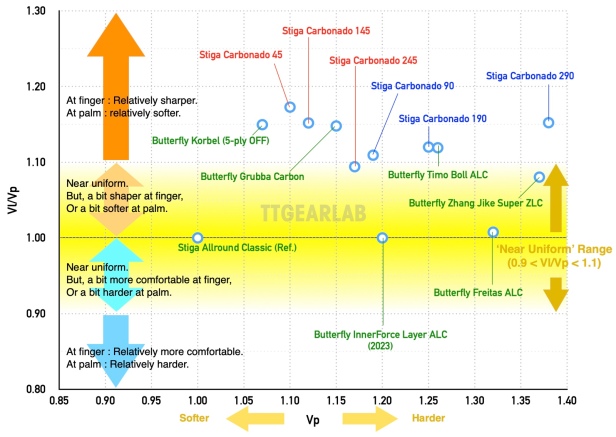
Fig.20 Vl/Vp vs. Vp
On the graph, the reference blade (= ‘Allround Classic’) is of course placed on the horizontal line whose Vl/Vp is 1.00. ‘Freitas ALC’ is also very close to that line. Those two are placed apparently lower than all the other blades in this comparison.
We can notice that ‘Carbonado 45’ and ‘Carbonado 145’ are placed at very high positions. Those two show very remarkable characteristic of relatively sharp feeling at fingertip of index finger. ‘Carbonado 290’ is also placed at very high position.
The three blades with unusually arranged TeXtreme – ‘Carbonado 45’, ‘Carbonado 145’ and ‘Carbonado 245’ are placed on one line. That line runs from upper left to lower right. It means that the relative sharpness at index finger is reduced if the density of TeXtreme is decreased. That is because Vl is not significantly affected by the density of TeXtreme. On the contrary, we can’t see that kind of phenomenon from ‘Carbonado X90’s whose TeXtreme fibers are arranged in ordinary orientation. In ordinary cases, Vl/Vp increases when the elasticity of fiber is increased while all the other factors are identical.
On the graph, we can also notice that ‘Carbonado 45’ and ‘Carbonado 145’ are placed very close to ‘Korbel’ although those two are somewhat harder (= higher Vp) than ‘Korbel’. There may be many players who don’t suffer from much trouble when they try to replace there ‘Korbel’ with ‘Carbonado 45’ or ‘Carbonado 145’. That will be very important advantage of ‘Carbonado 45’ and ‘Carbonado 145’. And, ‘Grubba Carbon’ is close to ‘Carbonado 145’. But, as we examined in former graphs, ‘Carbonado 145’ is much faster than ‘Grubba Carbon’.
As we have examined former graphs, ‘Carbonado 190’ is again very close to ‘Timo Boll ALC’. It is very interesting because those two are different from each other in fiber, top wood and thickness.
‘Carbonado 290’ is not that close to ‘Zhang Jike Super ZLC’ on the graph. However, if a player likes the high elasticity of ‘Zhang Jike Super ZLC’ but wants sharper feeling at index finger, ‘Carbonado 290’ will be best choice.

Fig.21 ‘Carbonado 45/90’

Fig.22 ‘Carbonado 145/190’
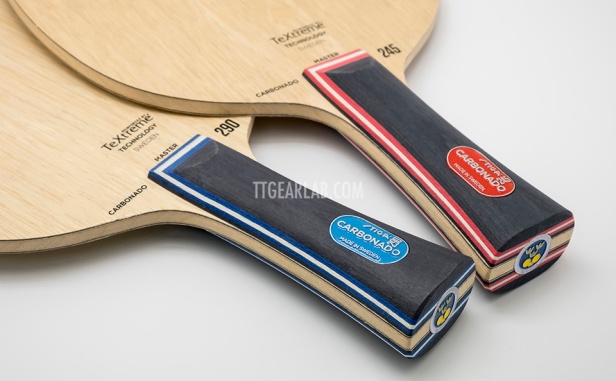
Fig.23 ‘Carbonado 245/290’
4. Summary
The result of comparison can be summarized as follows :
- ‘Carbonado 45’, ‘Carbonado 145’ and ‘Carbonado 245’ : The result of the unusual arrangement of TeXtreme that is rotated by 45 dgree is deeper hold of ball and softer feeling. These three models are amazingly soft and hold ball very deep when we make very strong impact.
- ‘Carbonado 90’, ‘Carbonado 190’ and ‘Carbonado 290’ : The characteristic of TeXtreme is not unique because the arrangement of fiber is ordinary. However, although it is a pure woven carbon fiber, TeXtreme is as soft as ALC. It is much softer than ordinary woven carbon fiber.
- If the density of TeXtreme is identical, the Ep (primary elasticity index) of ‘Carbonado X90’ is higher than that of ‘Carbonado X45’. (Density is one among 60g/㎡, 100g/㎡ and 200g/㎡. X is one among 0, 1 and 2.)
- Regardless of the density of TeXtreme, the Ec (central elasticity index) of ‘Carbonado X90’ is higher than that of ‘Carbonado Y45’, even in case X is smaller than Y. Also, the density of fiber doesn’t influence much on the central elasticity, if the orientation of fiber is rotated by 45 degree.
- Regardless of the density of TeXtreme, the Vp & Vl (vibration indices) of ‘Carbonado X90’ are higher than those of ‘Carbonado Y45’, even in case X is smaller than Y. It means that the rotated arrangement of fiber makes the blade softer. Also, the Vl of three ‘Carbonado X45s’ are almost identical, and are close to the Vl of 5-ply wood blade or inner-fiber blade. It means that the fiber doesn’t influence much on the lateral vibration. The result will be very natural feeling like 5-ply wood blade. That is the advantage of ‘Carbonado X45’.
- The one that is closest to ‘Korbel’ is ‘Carbonado 45’ as we can easily expect. ‘Carbonado 145’ is a bit harder and faster than ‘Carbonado 45’.
- The one that is closest to ‘Timo Boll ALC’ is ‘Carbonado 190’. ‘Carbonado 90’ is a bit softer and slower than ‘Carbonado 190’.
- The one that is closest to ‘Zhang Jike Super ZLC’ is ‘Carbonado 290’. It is faster than ‘Zhang Jike Super ZLC’, and provides relatively sharper feeling at index finger. ‘Carbonado 245’ is much different from ‘Zhang Jike Super ZLC’ or ‘Carbonado 290’.

Fig.24 ‘Carbonado 45/90’
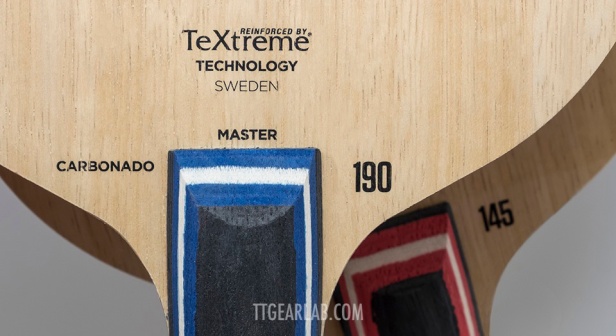
Fig.25 ‘Carbonado 145/190’
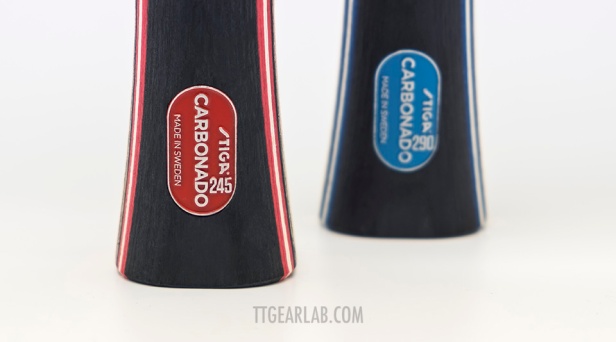
Fig.26 ‘Carbonado 245/290’

I might be missing something, but there appears to be a typo on the Ec/Ep graph (with carbonado 145 appearing two times). (see: https://imgur.com/o8sRRjG)
Wonderful analysis of the Carbonados!! Keep up the great work!
LikeLike
Thank you a lot! I will fix it as quickly as possible.
Of course the left bottom one is 245.
LikeLike
I would like to start by thanking you for such a thorough job analyzing the blades. However, I have a few questions does deep hold mean dwell which helps in spinning the ball. The 245 is closer to which butterfly blade? Also is the freitas any special it was in the middle constantly. Is it just a slower timo boll alc. Thank you very much and keep up the good work. If you can could you compare the butterfly zlc blades including the super zlc?
LikeLike
Thank you a lot for comment. ‘Deep hold’ is different from ‘dwell’. ‘Hold’ or ‘Kick’ is concerned with the deflection of blade. But, dwelling time is decided by the character of ball. That is one of many uniquenesses of table tennis. Among the balls of all sports, table tennis ball is a very strange one. (And, it also makes the science of table tennis very complex. There isn’t any TT maker that explains that fact, because it is somewhat too difficult for ordinary customers to understand.)
‘Carbonado 245’ is very unique blade. We can hardly find out a Butterfly blade that is similar to it. But, I think that ‘Carbonado 290’ can be compared with ‘Zhang Jike Super ZLC’. You will be able to see the data of Butterfly ‘SUPER ZLC’ blades in some articles.
LikeLiked by 1 person
I don’t understand how deep hold is different from dwell. If you have the time you should make a article explaining these concepts and also explaining like which blades suit what rubbers. That would help all Table tennis players a lot.
LikeLike
I think that is the problem of my word selection. Maybe ‘Hold’ isn’t a good word that explains the phenomenon. Different word for example ‘Center Deflection’ may be better. But, in fact that is a kind of feeling. The reason why I select the word ‘Hold’ is that the playrs feel that the blade holds the ball deep if the central elasticity is high low and the blade kicks the ball if the central elasticity is relatively high. And, that feeling is not concerned with the dwell time because the ball leaves the surface of rubber much ‘earlier’. The dwell time is only 1/1000 second. 🙂
LikeLike
You say that ec becomes relevant when u hit the ball hard so you mean topspin not smash right?
I was using the fang bo b2x which is basically the basic version of hl5x. It wasn’t fast but when you use your entire arm and body to tospin basically hitting the ball hard, you get spin on another level and there is so much kick effect. Pairing with boosted Hurricane 3 and its unbeatable. I wanted something better than fang bo b2x. Would u suggest long 5 x or stiga carbonado? I would prefer carbonado as it is faster but is it suitable with DHS rubbers?
LikeLike
It is concerned with both of topspin and smash as long as the impact is strong.
Carbonado series blades basically fit for DHS rubbers very well. Those are developed while being tested with DHS rubbers from the beginning. However, if you are changing your blade from Fang Bo B2X, I recommend Ovtcharov InnerForce ALC because it is very fast ‘inner ALC’ blade. It is faster than Fang Bo B2X.
LikeLike
I am an intermediate level table tennis player. I have tried DHS rubbers with timo boll alc, viscaria and it really doesn’t perform well. You would have to boost. But unboosted, non neo hurricane national on stiga clipper performs marvellous. I’ve noticed that DHS rubbers perform very well with pure wood/ limba ayous alc blade. But with koto or any other wood layers it just doesn’t perform well. So I will upgrade to stiga carbonado or stiga clipper cr in the future. That’s why DHS Wang chuqin, DHS sun Yingsha, DHS long 5 are made up of limba ayous alc .
LikeLike
As you mentioned, the combination of Stiga Clipper and non-boosted DHS rubbers is fantastic. In speed glue era I used G888 with Clipper for some time, and it was really fantasitic.
If you couldn’t get good result from the combination of DHS rubbers with Viscaria and TB ALC, Stiga Carbonado series is worth considering.
LikeLike
Thanks for the great work.
I understand why Ep is lower on x45 blades than x90’s considering the lower relative length deviation during deformation. But I supposed that the center deflection would be more or less independent of orientation because deflection occurs in every direction. Do you have an idea why that is.
LikeLike
Thank you for comment.
The center deflection will be independent from the orientation of fiber if the shape of blade is perfect circle. However, the shape of blade isn’t perfect circle.
And, there is more important factor – handle of blade. The vertical fiber of X90 is placed from the top of blade to the end of handle. However, any fiber of X45 is directly connected to handle. The center deflection of the fiber of X90 is constrained by handle. But, the center deflection of the fiber of X45 is not. If we ignore wood layers, the center deflection of X45 is close to free deflection while that of X90 is constrained deflection.
LikeLike
thank you for the great work. your analysis on blade characteristic is exquisite! just like the rating given on butterfly website. what is your opinion on stiga’s latest product- dynasty carbon? It’s stated as improvised version of carbonado series blade, and textreme carbon + instead of just textreme carbon. Would love to see your detail review!
LikeLike
Thank you for comment. I’m preparing for the article on Dynasty Carbon. It seems that it is the variation from Carbonado 45 or Carbonado 145. The most important difference from Carbonado series is the top layer. The top layer of Carbonado series is Limba. But, the top layer of Dynasty Carbon is Koto. Although Dynasty Carbon has harder top layer when compared to Carbonado 190, it is softer and less elastic than Carbonado 190.
LikeLike
Did you come across any of the mythical “short serial” (12-number) Carbonado 45? They’re not really mythical, as they do exist. However, the idea that they are higher quality than the regular 15-number is yet to be validated. Any idea?
LikeLike
How could you check the serial number of Carbonado series?
LikeLike
I mean by looking at the blade’s handle and counting the numbers. “Short serial” has 12 digits. The regular version has 15. The short serial version has a reputation of being the “professional” edition used by female China national players. But this is hearsay. Gan’s review on youtube tests one of these blades: https://tinyurl.com/2t2pz8b5 Naturally, these blades are being sold at a much higher price in China (and some people attempt to fake them).
LikeLike
Thank you for explanation. Then probably it will be difficult for me to get those blades with serial numbers. The serial numbers seem to be applied only in Chinese market, and I don’t have any Stiga blades those have serial numbers.
LikeLike
I just watched a match of Kou Lei in semifinal against Samsonov in Baku 2015. In that match seems Kou Lei was used Carbonado 190 blade.
LikeLike
Thank you for information.
It seems that he is changing blades among Carbonado series. For example Carbonado 245, Carbonado 45, …… and Carbonado 190 you mentioned.
LikeLike